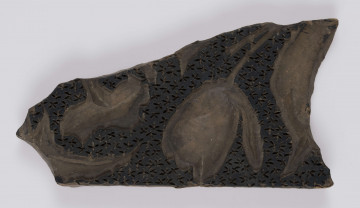
Block for printing on textile
1901 — 1950
National Museum in Lublin
Part of the collection: Fabric printing matrices
Textile printing is a long-known technique of decorating fabrics, which came to Europe from the East. Printing workshops functioned both in large cities as well as in smaller towns. The products they made were very popular thanks to, among others, the way they could imitate expensive materials. Since printing on fabrics required only few tools, even travelling craftsmen provided such services, satisfying the demands for printed textiles of the people living in the country. In many towns, the growth of hand textile printing was halted with the development of large factories. Some craftsmen moved then to the country, where they could still enjoy high demand for their products. In the second half of the 19th century in many regions, including Pomerania, there were still many local printing workshops. As markets were flooded with factory fabrics, the number of customers for handmade prints shrank and eventually the small workshops could no longer compete with the modern textile industry. In printing workshops, besides the simple method of directly imprinting the design on the fabric using a block covered with ink, the batik printing technique was used. It involved applying an insulating paste to the material, which protected the covered areas from the effects of the dye. The result was an unpainted ornament on a coloured background. Textile printing used special blocks, which in time were more and more intricate. The presented stamp has an ornament depicting small flowers arranged in a checkerboard pattern, which is made entirely of brass sticks and plates hammered into wood. The stamps made with this technique appeared only in the 19th century. Initially, the decorative motifs were made entirely on wooden blocks, but in time they were enriched with the addition of small, metal elements. In time they completely replaced the carved patterns.
Author / creator
Dimensions
cały obiekt: height: 5 cm, width: 19,6 cm
Object type
matrix
Creation time / dating
Creation / finding place
Identification number
Location / status

1901 — 1950
National Museum in Lublin

1901 — 1950
National Museum in Lublin

1901 — 1950
National Museum in Lublin
DISCOVER this TOPIC
Castle Museum in Łańcut
DISCOVER this PATH
Educational path